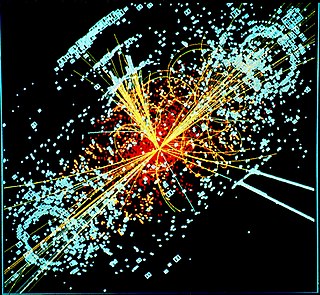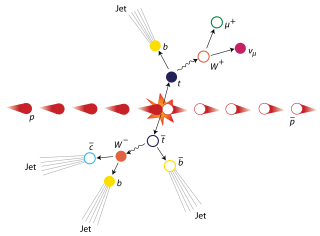
Grand Unified Theory (GUT) is any model in particle physics that merges the electromagnetic, weak, and strong forces into a single force at high energies. Although this unified force has not been directly observed, many GUT models theorize its existence. If the unification of these three interactions is possible, it raises the possibility that there was a grand unification epoch in the very early universe in which these three fundamental interactions were not yet distinct.

In nuclear physics and particle physics, the weak interaction, also called the weak force, is one of the four known fundamental interactions, with the others being electromagnetism, the strong interaction, and gravitation. It is the mechanism of interaction between subatomic particles that is responsible for the radioactive decay of atoms: The weak interaction participates in nuclear fission and nuclear fusion. The theory describing its behaviour and effects is sometimes called quantum flavordynamics (QFD); however, the term QFD is rarely used, because the weak force is better understood by electroweak theory (EWT).

The Standard Model of particle physics is the theory describing three of the four known fundamental forces in the universe and classifying all known elementary particles. It was developed in stages throughout the latter half of the 20th century, through the work of many scientists worldwide, with the current formulation being finalized in the mid-1970s upon experimental confirmation of the existence of quarks. Since then, proof of the top quark (1995), the tau neutrino (2000), and the Higgs boson (2012) have added further credence to the Standard Model. In addition, the Standard Model has predicted various properties of weak neutral currents and the W and Z bosons with great accuracy.

In particle physics, a lepton is an elementary particle of half-integer spin that does not undergo strong interactions. Two main classes of leptons exist: charged leptons, including the electron, muon, and tauon, and neutral leptons, better known as neutrinos. Charged leptons can combine with other particles to form various composite particles such as atoms and positronium, while neutrinos rarely interact with anything, and are consequently rarely observed. The best known of all leptons is the electron.

The top quark, sometimes also referred to as the truth quark, is the most massive of all observed elementary particles. It derives its mass from its coupling to the Higgs boson. This coupling yt is very close to unity; in the Standard Model of particle physics, it is the largest (strongest) coupling at the scale of the weak interactions and above. The top quark was discovered in 1995 by the CDF and DØ experiments at Fermilab.

Technicolor theories are models of physics beyond the Standard Model that address electroweak gauge symmetry breaking, the mechanism through which W and Z bosons acquire masses. Early technicolor theories were modelled on quantum chromodynamics (QCD), the "color" theory of the strong nuclear force, which inspired their name.
In theoretical physics, a chiral anomaly is the anomalous nonconservation of a chiral current. In everyday terms, it is equivalent to a sealed box that contained equal numbers of left and right-handed bolts, but when opened was found to have more left than right, or vice versa.

In particle physics, the W and Z bosons are vector bosons that are together known as the weak bosons or more generally as the intermediate vector bosons. These elementary particles mediate the weak interaction; the respective symbols are
W+
,
W−
, and
Z0
. The
W±
bosons have either a positive or negative electric charge of 1 elementary charge and are each other's antiparticles. The
Z0
boson is electrically neutral and is its own antiparticle. The three particles each have a spin of 1. The
W±
bosons have a magnetic moment, but the
Z0
has none. All three of these particles are very short-lived, with a half-life of about 3×10−25 s. Their experimental discovery was pivotal in establishing what is now called the Standard Model of particle physics.
R-parity is a concept in particle physics. In the Minimal Supersymmetric Standard Model, baryon number and lepton number are no longer conserved by all of the renormalizable couplings in the theory. Since baryon number and lepton number conservation have been tested very precisely, these couplings need to be very small in order not to be in conflict with experimental data. R-parity is a symmetry acting on the Minimal Supersymmetric Standard Model (MSSM) fields that forbids these couplings and can be defined as

The Minimal Supersymmetric Standard Model (MSSM) is an extension to the Standard Model that realizes supersymmetry. MSSM is the minimal supersymmetrical model as it considers only "the [minimum] number of new particle states and new interactions consistent with "Reality". Supersymmetry pairs bosons with fermions, so every Standard Model particle has a superpartner. If discovered, such superparticles could be candidates for dark matter, and could provide evidence for grand unification or the viability of string theory. The failure to find evidence for MSSM using the Large Hadron Collider has strengthened an inclination to abandon it.
In the Standard Model of electroweak interactions of particle physics, the weak hypercharge is a quantum number relating the electric charge and the third component of weak isospin. It is frequently denoted and corresponds to the gauge symmetry U(1).
In particle physics, flavour or flavor refers to the species of an elementary particle. The Standard Model counts six flavours of quarks and six flavours of leptons. They are conventionally parameterized with flavour quantum numbers that are assigned to all subatomic particles. They can also be described by some of the family symmetries proposed for the quark-lepton generations.
In quantum field theory, and specifically quantum electrodynamics, vacuum polarization describes a process in which a background electromagnetic field produces virtual electron–positron pairs that change the distribution of charges and currents that generated the original electromagnetic field. It is also sometimes referred to as the self-energy of the gauge boson (photon).

Two-photon physics, also called gamma–gamma physics, is a branch of particle physics that describes the interactions between two photons. Normally, beams of light pass through each other unperturbed. Inside an optical material, and if the intensity of the beams is high enough, the beams may affect each other through a variety of non-linear effects. In pure vacuum, some weak scattering of light by light exists as well. Also, above some threshold of this center-of-mass energy of the system of the two photons, matter can be created.

This article describes the mathematics of the Standard Model of particle physics, a gauge quantum field theory containing the internal symmetries of the unitary product group SU(3) × SU(2) × U(1). The theory is commonly viewed as describing the fundamental set of particles – the leptons, quarks, gauge bosons and the Higgs boson.

Physics beyond the Standard Model (BSM) refers to the theoretical developments needed to explain the deficiencies of the Standard Model, such as the inability to explain the fundamental parameters of the standard model, the strong CP problem, neutrino oscillations, matter–antimatter asymmetry, and the nature of dark matter and dark energy. Another problem lies within the mathematical framework of the Standard Model itself: the Standard Model is inconsistent with that of general relativity, and one or both theories break down under certain conditions, such as spacetime singularities like the Big Bang and black hole event horizons.
Asım Orhan Barut was a Turkish-American theoretical physicist.
In particle physics, an oblique correction refers to a particular type of radiative correction to the electroweak sector of the Standard Model. Oblique corrections are defined in four-fermion scattering processes, at the CERN Large Electron–Positron Collider. There are three classes of radiative corrections to these processes: vacuum polarization corrections, vertex corrections, and box corrections. The vacuum polarization corrections are referred to as oblique corrections, since they only affect the mixing and propagation of the gauge bosons and they do not depend on which type of fermions appear in the initial or final states.
In particle physics, the Peskin–Takeuchi parameters are a set of three measurable quantities, called S, T, and U, that parameterize potential new physics contributions to electroweak radiative corrections. They are named after physicists Michael Peskin and Tatsu Takeuchi, who proposed the parameterization in 1990; proposals from two other groups came almost simultaneously.






